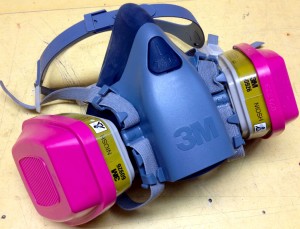
New respirator purchased for worker after fit test
You might think your respirator fits, but you could be wrong.
Recently I talked with a worker in a film production studio where props and artwork are created. He and his coworkers recently took part in an on-site respirator fit test from Actsafe, BC’s safety association for entertainment industries.
“In my case, the mask was much too small and didn’t even go below my chin,” said the worker, describing what he learned. “I upsized to one that fit properly. The respirator face piece must fit over the nose and under the chin, and should make a seal that doesn’t allow air in or out.”
He needs protection against a number of airborne contaminants that could be found in the shop, depending on what projects people are working on.
“We have many different airborne hazards including particulate swarf (sawdust, metal/plastic filings, plaster dust, fibreglass shavings, etc), and various chemical fumes (fibreglass resins, polyfoam compounds containing ammonia, adhesives, paints, and solvents),” he said. “Flammable and volatile substances are stored in fireproof cabinets.”
Respirators are a second line of defence after other engineered controls.
“We have three rooms equipped with elaborate air extraction systems which filter/exhaust fumes. These are ceiling/wall vent duct systems with large-volume fan extractors and replaceable filters,” the worker said.
“We have a paint room (paints, solvents, adhesives); a foam room (polyfoam and foam-latex moldmaking); and a hot room (fibreglass resins/dust, plaster dust, combustion fumes, solvents, adhesives). Workers are required to turn on the ventilation system when working in any of these areas. The main shop area also has a large rooftop air intake vent and ceiling fans throughout to provide fresh air and mitigate dust/fumes in the air.”
Ready for use
All shop workers are supplied with their own personal – fitted and labelled – respirators.
“When not in use, they’re stored in sealed plastic bags. We have a supply of new filter cartridges that workers replace regularly according to manufacturer guidelines,” he said.
“Asthma and lung problems can be brought on by years of repeated low-level exposure to many of the toxins involved. Workers can suffer long-term serious damage to lungs if proper precautions are not taken.”
For more information, read Breathe Safer: How to Use a Respirator Effectively and Start a Respirator Program.



Pingback: How Do You Know Your Respirator Fits? | Compliance and Safety Blog
Pingback: How do you know your respirator fits?
I can’t agree more. At the University of Washington, we developed a video that graphically shows how a poorly fitted or adjusted N95 filtering face-piece respirator can allow a worker to be exposed to harmful agents. The video also shows that facial hair prevents a good seal from forming between the respirator and the face. You can check it out at: http://deohs.washington.edu/FRCG/project/controls/N95.
Feel free to use it for training.
Happy viewing.
Marty Cohen, ScD, CIH, CSP
Sr. Lecturer
Director, Field Research and Consultation Group
Department of Env. and Occup. Health Sciences
University of Washington